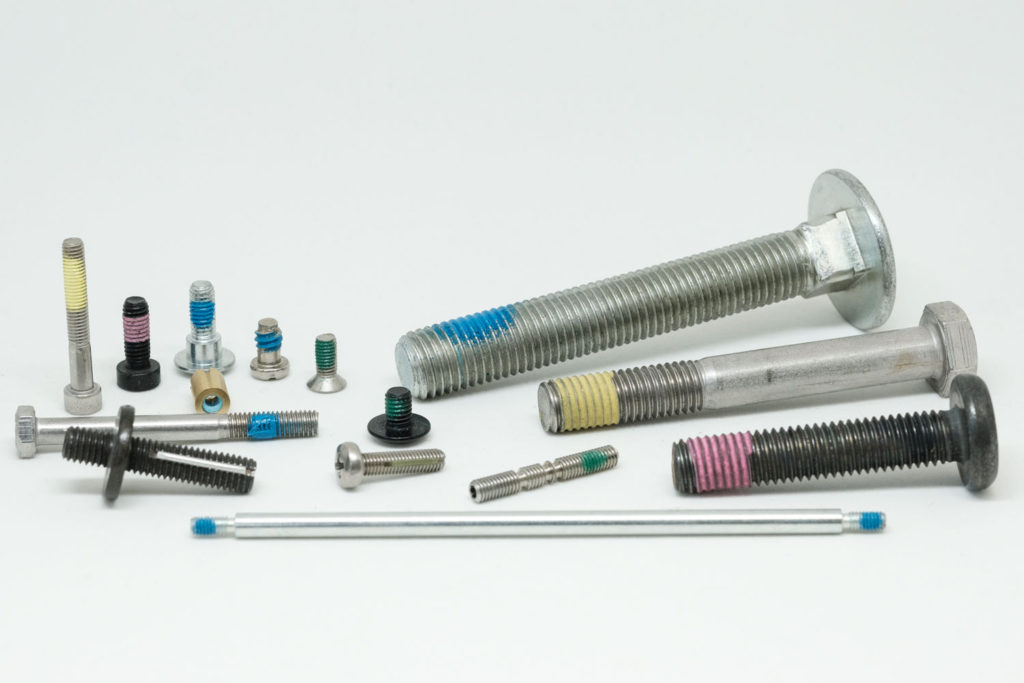Threadlockers and connecting parts from one source
As an independent partner, we will provide you with the complete connection and advise you on the selection of the appropriate process. Secure your threads without additional mechanical locking elements.
The selection and the possibilities of thread locking procedures is great and we have the necessary experience to advise you competently. Nevertheless, we would like to show you some of the possibilities, so that you can see how varied the possibilities are.

The proven blue original
Benefits:
- Economical proven protection against the automatic loosening of screws
- Tight against liquids and gases with all-round coating
- Multiple reusable
- Low installation costs and elimination of additional mechanical security elements
- No damage to the surfaces and counterparts
- Also for screws that must not be weakened in cross-section
- Suitable for small screws from M 1
- Long durability
Product features
The threaded parts are inductively heated and fed to the coating on special machines.
There, the highly elastic and abrasion-resistant nylon layer is applied to a part of the thread.
This method is extremely well suited to secure screws and connecting parts against loosening and loosening.
Since Tuflok does not dry out, shrinks or decomposes, it is characterized by a particularly good durability.
The threaded parts can be reused several times. Tuflok has a temperature resistance of - 56 ° C to 120 °.
For higher loads up to 200 ° a Nytemp fuse is offered.
Through this clamping thread locking a high vibration safety and an extremely high release torque is achieved.
Torques
For testing the torques, nuts with tolerance 6 H and 10 thread pitching are used. The test nut must be countersunk 90 °.
Deviating torques and test methods require a separate agreement and usually require a sample coating.
We are happy to assist you with special problem solutions.
Location of the coating
The first 2 to 3 threads remain uncoated so that the connecting parts can be easily screwed in.
On the following 4 to 6 threads the Tuflok coating is applied.
To seal the connection against liquids and gases, a 360 ° circular coating is recommended.
In addition, special requests for the position and length of the coating can be largely taken into account.
In doing so, the spread area has to be included in the planning.
General information
The listed data was created to the best of our knowledge and is for informational purposes only. Before use, detailed tests should be carried out.
The data can be used as a basis.
However, no liability can be assumed for these data and results.
Advantages:
- Environmentally friendly and recyclable
- Can be used without health risk
- More usable
- No peeling of particles
- Thread colorless (without dyes available)
- High release torque
- Long durability
- Removal of additional mechanical security elements
- Reduced installation costs
- Consistent screwing through precise tolerances
Process
A groove is milled into the screw thread until just below the core diameter and an elastically deformed special thread is pressed in. This thread lock achieves a high level of vibration safety and an exceptionally high release torque (exceeds the requirement of DIN 267 part 28).
Thanks to the many special variation options, NormTight® can be used very universally.
Clamping coating according to DIN 267 part 28
Product features
According to the DIN 267 part 28, a plastic is applied to the thread and thus produces a clamping effect.
Different methods and types of securing are permissible. The clamping elements may be in the form of a spot coating, a circular coating or a strip-shaped coating and in different colors.
The coating prevents complete loosening of a connection, but not loosening.
The connecting parts with a clamping coating are intended according to the provisions in the standard only for a single use.
Only when used as adjusting or adjusting screw a repeated use must be possible.
scopes
Steel screws with metric ISO thread Application range - 50 ° C to 90 ° C Thread diameter from 3 mm to 16 mm Strength classes according to DIN 898 Part 1.
The standard does not apply to fuses requiring additional machining. The test values of the threaded parts must have a shelf life of 2 years if properly stored inside.
Torques
Deviating torques require a separate agreement and usually require a test coating.
exams
Please refer to the DIN 267 part 28 for the individual regulations for the testing of connecting parts with clamping coating. The test nuts must meet the following criteria: the nut height is 0,8 to 0,9 d (nominal diameter) the nut must be countersunk on both sides 120 ° the strength must be at least equal to the strength class of the screw select the thread tolerance 6 H.
The thread surface is bare or bright black.
The thread must be free of oil and grease. The thread must be free of chips and burrs.
Other test nuts are only allowed by agreement.
General information
The listed data was created to the best of our knowledge and is for informational purposes only.
Before use, detailed tests should be carried out.
The data can be used as a basis.
However, no liability can be assumed for these data and results.
Adhesive coating according to DIN 267 part 27
Product features
For connectors with adhesive coating according to DIN 267 Part 27, a microencapsulated adhesive is applied to the thread.
When tightening the mating threads, the microcapsules burst and the adhesive spreads in the thread.
The usual products on the market differ by different curing times and breakaway moments.
It has to be taken into account for which temperature range the application is planned.
Only clean and residue-free parts should be used.
Adhesive coatings according to standard are always circular coatings. Adhesive coating connectors are for single use only.
Adhesive coatings counteract the loosening of the screw connections.
scopes
Steel screws with metric ISO thread Application range - 50 ° C to 90 ° C Thread diameter from 3 mm to 16 mm Strength classes according to DIN 898 Part 1.
The test values of the threaded parts must have a shelf life of 2 years if properly stored inside. Screws with adhesive coatings must be protected against moisture. As long as the test values are met, color changes have no influence.
exams
Please refer to the DIN 267 part 27 for the individual regulations for the testing of connecting parts with adhesive coating. The test nuts must meet the criteria below; the height of the nut is 0,8 to 0,9 d (nominal diameter) the nut must be countersunk 120 ° on both sides the strength must be at least equal to the strength class of the screw the thread tolerance 6 H must be selected. The thread surface is bare or bright black. The thread must be free of oil and grease. The thread must be free of chips and burrs.
Other test nuts are only allowed by agreement.
General information
The listed data was created to the best of our knowledge and is for informational purposes only. Before use, detailed tests should be carried out. The data can be used as a basis. However, no liability can be assumed for these data and results.
